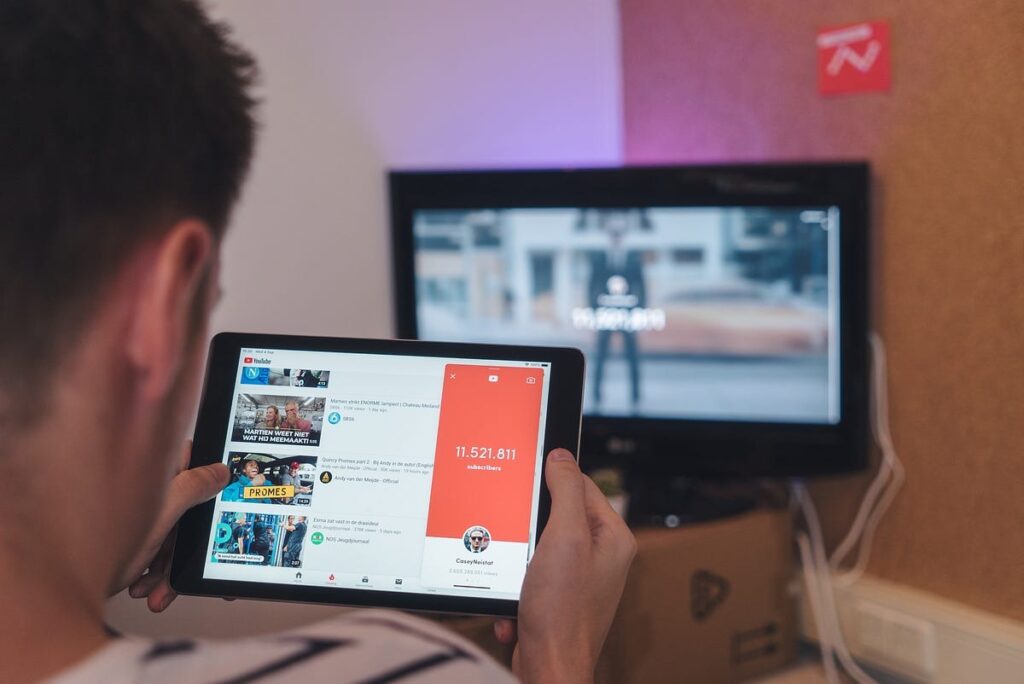In an era dominated by digital connections, YouTube social media stands out as a beacon of influence, profoundly shaping how information is shared and consumed globally. With its inception over a decade ago, YouTube has revolutionized video sharing and livestreaming, becoming an essential tool for marketers, influencers, and content creators. Its impact on social media trends is undeniable, significantly altering the landscape of online communication and interaction. This phenomenon underlines the importance of understanding YouTube’s role in the evolving digital ecosystem, particularly how it molds consumer preferences and behaviors.
As we delve further into the heart of YouTube social media marketing and its broader implications, our discussion will span several crucial areas. We’ll examine YouTube’s dominance within the social media ecosystem, highlighting its unparalleled reach and the diverse demographic it attracts.
YouTube’s Dominance in the Social Media Ecosystem
You have witnessed YouTube’s meteoric rise to become the undisputed leader in the social media ecosystem. With a staggering 2.49 billion monthly active users, YouTube’s potential ad reach encompasses half of the 5.04 billion global social media users, solidifying its position as the second most widely used platform.
Market Share Statistics
The United States contributes the highest YouTube traffic at 21.93%, surpassing India, which accounts for only 8.11% of the platform’s traffic. This dominance extends beyond user engagement, as 86% of content marketers consider YouTube at least somewhat effective for their strategies, ranking it second only to LinkedIn.
Comparison with Other Platforms
While YouTube reigns supreme, other platforms have also carved their niches. Facebook commands a substantial 68% of U.S. adult usage, followed by Instagram at 47%. Platforms like Pinterest, TikTok, LinkedIn, WhatsApp, and Snapchat attract 27% to 35% of American adults, while Twitter (X) and Reddit garner around one-fifth of the adult population.
Notably, TikTok has experienced a surge in its user base, with one-third (33%) of U.S. adults using the video-based platform in 2024, a significant increase from 21% in 2021. However, most other platforms have seen modest or stagnant growth during the same period, further solidifying YouTube’s dominance in the social media landscape.
Demographic Trends on YouTube
YouTube has a diverse user base spanning various age groups, but certain demographics stand out as more prominent consumers. The largest age group using the platform is between 25 and 34 years old, accounting for a staggering 21.3% of YouTube’s user base. This age bracket, comprising young professionals and millennials, showcases the platform’s appeal to a tech-savvy and content-hungry audience.
The second-largest age group on YouTube falls between 35 and 44 years old, further solidifying the platform’s popularity among working professionals and established adults. Notably, YouTube also enjoys significant traction among young adults aged 18 to 24, capturing 15.5% of its user base, highlighting its relevance to the youth demographic.
While YouTube boasts a global reach, certain regions stand out as dominant contributors to its user base and traffic. India has emerged as the country with the largest YouTube audience, boasting an impressive 462 million active users as of October 2023. This staggering number underscores the platform’s widespread adoption in the world’s second-most populous nation.
Trailing closely behind India is the United States, with a substantial 239 million active YouTube users. Brazil, another populous country, ranks third with 144 million users, further cementing YouTube’s position as a global phenomenon.
Interestingly, despite having a smaller user base compared to India, the United States drives the most YouTube traffic, contributing 21.93% of the platform’s overall traffic. This discrepancy highlights the varying consumption patterns and engagement levels across different regions, with American users potentially being more active on the platform.
YouTube’s Role in Shaping Communications
YouTube’s immense success can be attributed to its focus on user-generated content. Unlike traditional media channels, YouTube allows anyone with a camera and an internet connection to create and share videos. This democratization of content creation has given rise to a diverse array of voices and perspectives. You can now communicate your ideas, stories, talents, and opinions with a worldwide audience, regardless of your background or location.
Impact on Modern Communication
YouTube’s comment section has emerged as a virtual gathering place where you can interact with content creators and fellow viewers. This interaction fosters community, sparking discussions, debates, and collaborations. The comment section becomes an avenue for like-minded individuals to share their thoughts and experiences, significantly strengthening the sense of belonging in the digital era.
Beyond just entertainment, YouTube has become a vast reservoir of educational content. You can access tutorials, lectures, and how-to guides on almost any subject. This democratization of knowledge has revolutionized how you learn, allowing for self-paced and personalized education. From mastering a musical instrument to learning a foreign language, YouTube has made acquiring new skills accessible to everyone.
Role in Public Discourse
YouTube has been instrumental in social activism and raising awareness about various issues. Activists, non-governmental organizations, and ordinary individuals can use the platform to share stories of injustice, discrimination, or humanitarian crises, sparking empathy and a call to action. The visual and emotional impact of videos has the power to mobilize millions of people globally, creating a ripple effect for positive change.
The rise of YouTube influencers has fundamentally altered the advertising and marketing landscape. With their large and dedicated following, influencers can influence your consumer behavior and trends. Unlike traditional celebrities, YouTube influencers are relatable, approachable, and often seen as friends rather than distant personalities. This authenticity has created a new form of advertising and communication between brands and consumers.
YouTube has broken down geographical barriers, enabling cultural exchange on an unprecedented scale. You can share your customs, traditions, and art forms with the world, fostering cross-cultural understanding and appreciation. This virtual global village has enabled us to celebrate our similarities and embrace our differences, promoting a more inclusive and tolerant world.
Challenges and Controversies
Despite YouTube’s immense popularity and influence, it has faced several challenges and controversies that have sparked debates and raised concerns among users, content creators, and regulatory bodies.
Misinformation and Content Moderation
One of the most significant challenges YouTube faces is the spread of misinformation and the moderation of harmful content. With billions of videos uploaded and shared on the platform, it becomes a daunting task to monitor and filter out misleading or deceptive information that could pose serious risks. YouTube has implemented policies and guidelines to address misinformation, relying on expert consensus from international health organizations and local authorities.
YouTube’s approach to tackling misinformation is based on the “4 Rs” principles:
- Remove: YouTube removes content that violates its policies, such as misleading or deceptive information that poses a serious risk of egregious harm.
- Reduce: YouTube reduces recommendations of borderline content or potentially harmful misinformation that comes close to violating its guidelines.
- Raise: YouTube raises up authoritative sources for news and information, using signals like relevance, freshness, and expertise to determine the content displayed in its officially-labeled news surfaces.
- Reward: YouTube rewards trusted creators by allowing them to monetize their content through the YouTube Partner Program, provided they comply with the platform’s guidelines and advertiser-friendly content policies.
While YouTube has implemented these measures, the challenge of effectively moderating content and combating misinformation remains an ongoing battle, requiring constant vigilance and adaptation to evolving tactics employed by bad actors.
Privacy Concerns
Another significant challenge YouTube faces is addressing privacy concerns and ensuring user data protection. As a platform that collects and processes vast amounts of user data, YouTube has a responsibility to safeguard users’ personal information and maintain transparency about its data practices.
YouTube’s Privacy Guidelines aim to protect users’ privacy and sense of safety while balancing public interest and newsworthiness. The platform emphasizes that it does not sell users’ personal information to anyone and uses the collected data to customize services, provide recommendations, personalize search results, and serve relevant ads.
However, concerns have been raised regarding the extent of data collection, the use of location information, and the potential for targeted advertising based on user activity and interests. YouTube has implemented measures to give users control over their data, such as the ability to manage activity data, turn off personalized ads, and choose to automatically delete data after a certain period.
Despite these efforts, privacy advocates and regulators continue to scrutinize YouTube’s data practices, highlighting the need for ongoing transparency, user control, and robust data protection measures to maintain user trust and comply with evolving privacy regulations.
As YouTube continues to shape social media consumption trends, addressing these challenges and controversies will be crucial in fostering a safe, trustworthy, and responsible platform for users and content creators alike.
Conclusion
By examining the platform’s comprehensive impact, from fostering global connectivity to propelling social activism, we’ve seen how YouTube doesn’t just mirror society’s evolving digital engagement patterns but actively shapes them, continuously altering the way information is shared and consumed globally.
The ongoing discussion around YouTube’s influence invites further research and engagement from both the digital community and stakeholders, setting the stage for a future where the potentials and pitfalls of video sharing technology are increasingly pivotal to our global digital experience.






